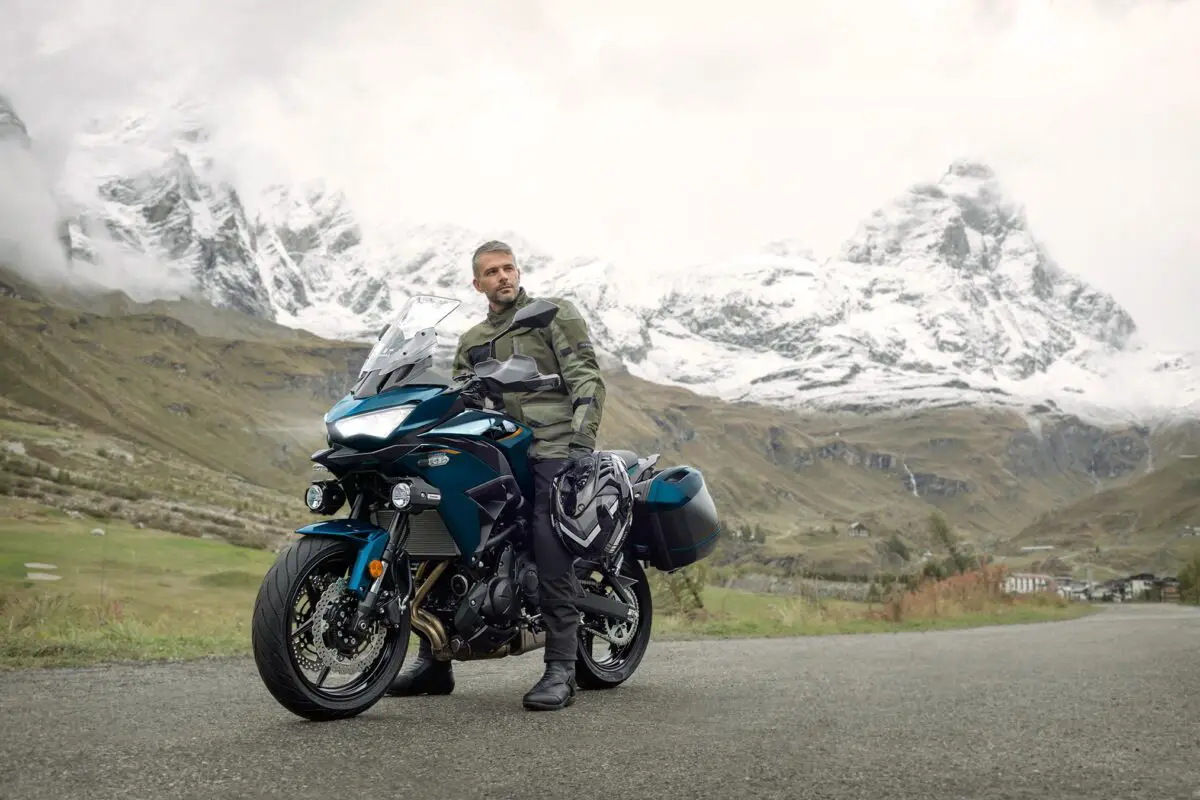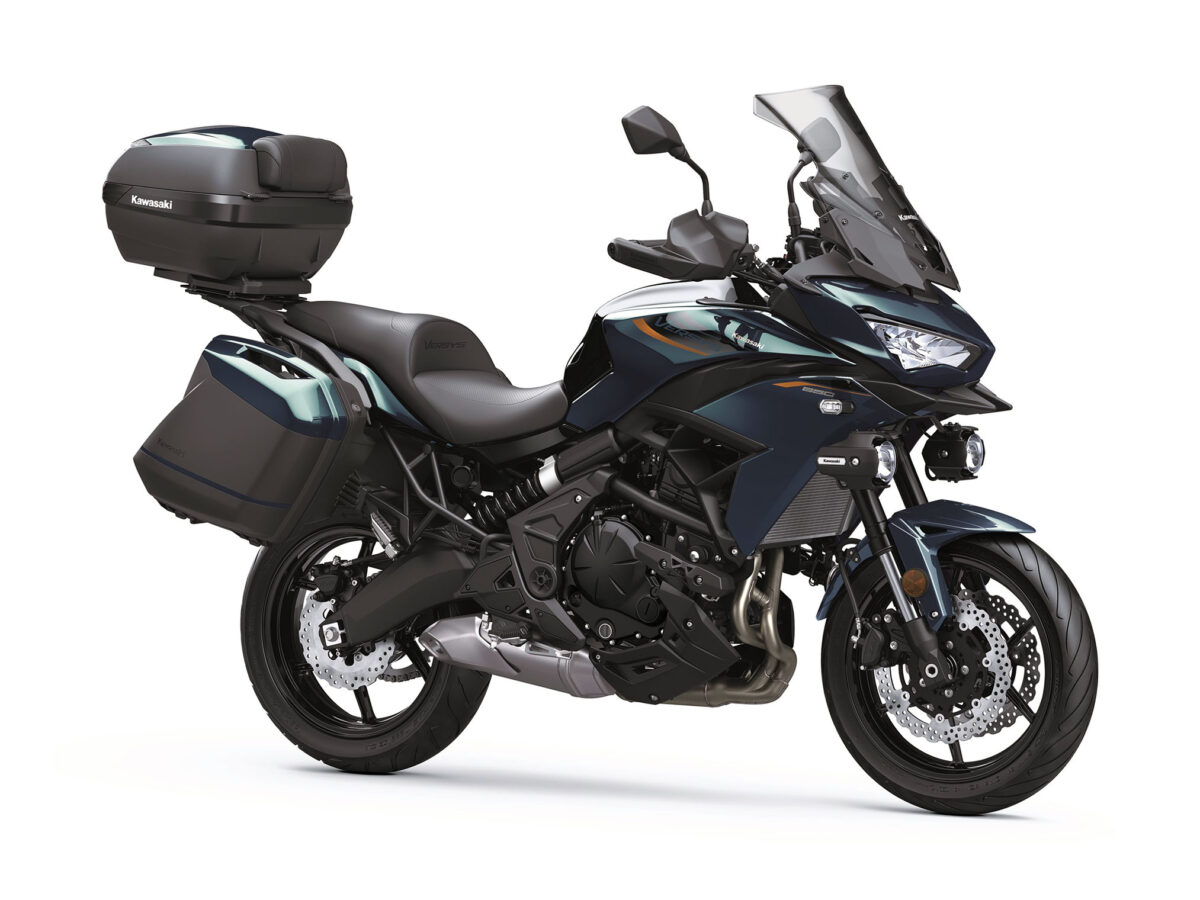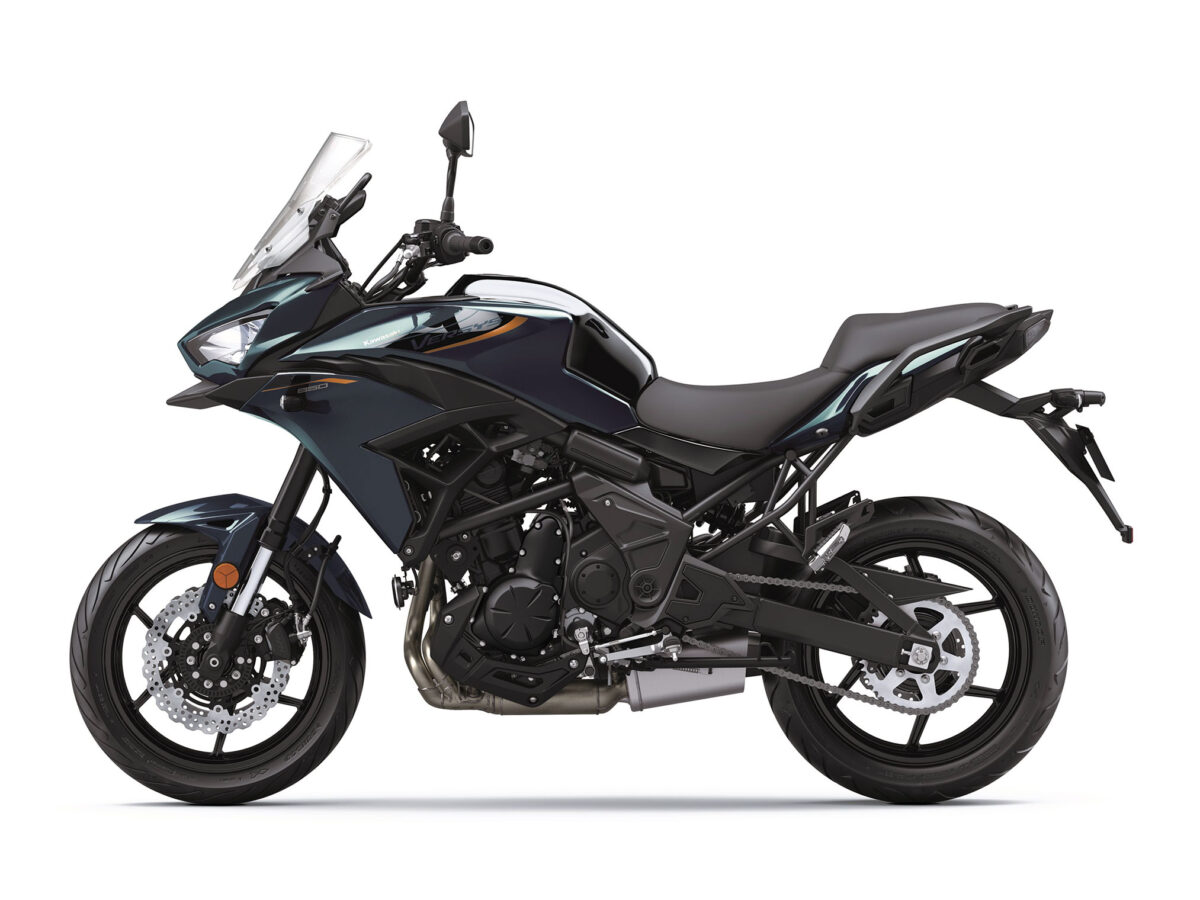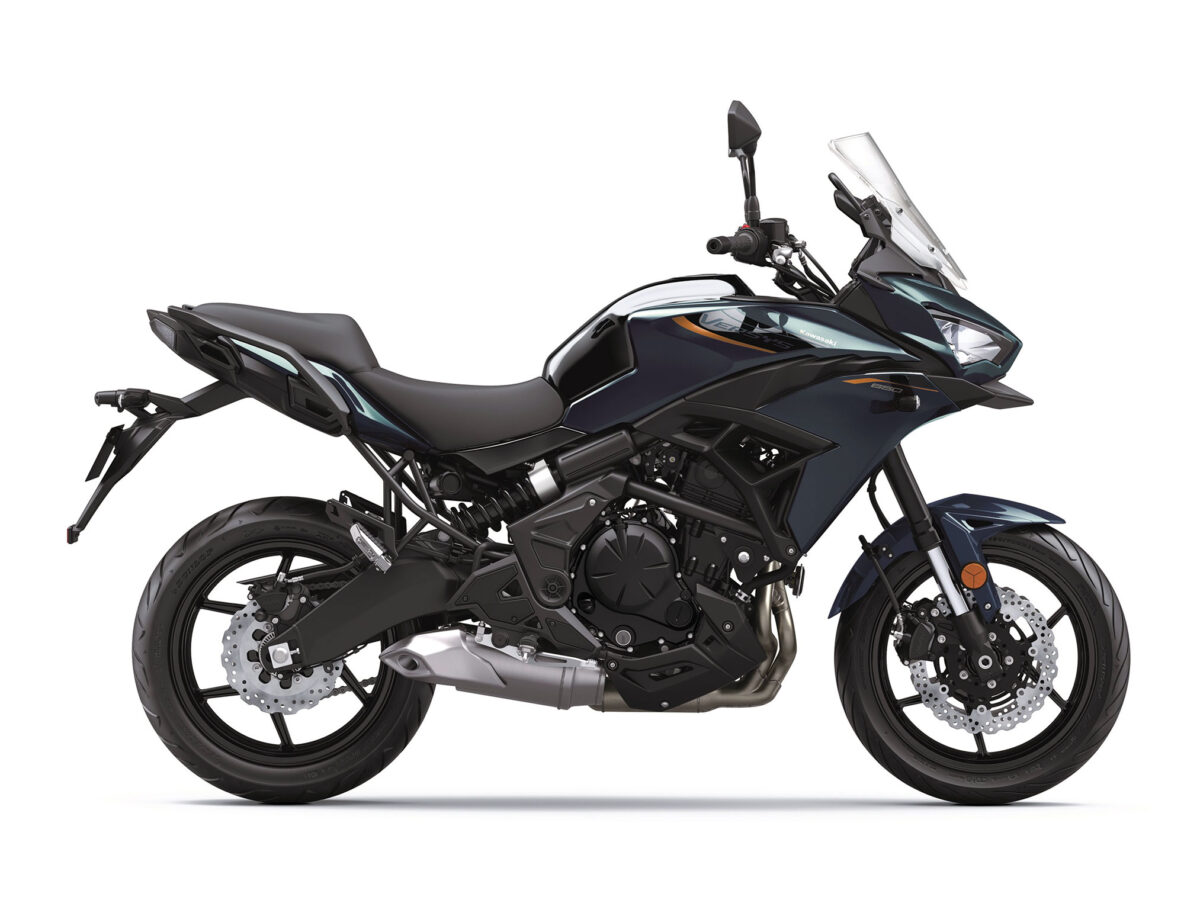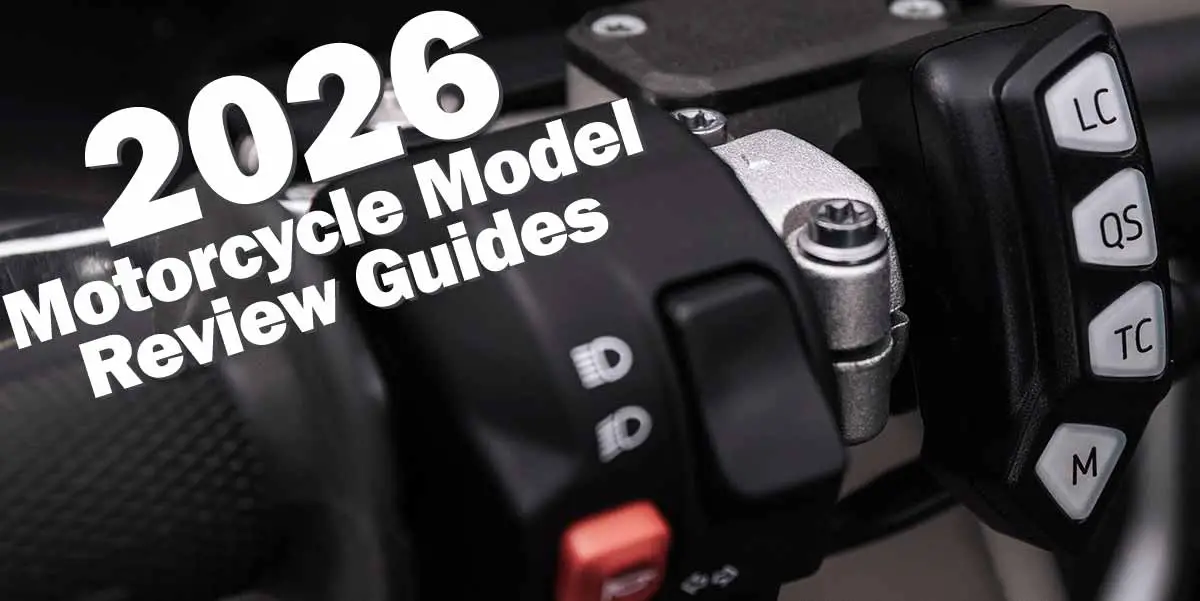
The Versys 650 LT ABS features a fuel-injected 649cc, parallel twin engine, upright riding position, Kawasaki TRaction Control (KTRC), TFT color LCD screen, Smartphone Connectivity via RIDEOLOGY THE APP MOTORCYCLE, LED taillight and headlights, large 5.5-gallon fuel tank, and a 4-way adjustable windshield.
Review – Key Features – Features & Benefits – Specifications
2026 Kawasaki Versys 650 LT ABS: ANY ROAD. ANY TIME.
Introducing the 2026 Kawasaki Versys 650 LT ABS…
The Versys 650 LT ABS is ready to take on any road, any time for your next adventure with its long-travel suspension, proven reliability, back-road capabilities, and superb fuel efficiency. It continues to be a top choice as the ultimate travel guide for riding enthusiasts who are looking for reliable performance and versatile fun. The Versys 650 LT ABS features a fuel-injected 649cc, parallel twin engine, upright riding position, Kawasaki TRaction Control (KTRC), TFT color LCD screen, Smartphone Connectivity via RIDEOLOGY THE APP MOTORCYCLE, LED taillight and headlights, large 5.5-gallon fuel tank, and a 4-way adjustable windshield. The Versys 650 LT ABS comes equipped with hand guards that help protect the rider’s hands against weather and wind, and a 28-liter KQR hard saddlebag set with quick release capabilities that can be removed and installed without the use of tools and offers enough space to fit a full-face helmet. The hard saddlebag set also utilizes Kawasaki’s One Key System to keep things as simple as possible with the use of the ignition key. The 2026 Versys 650 LT ABS is available in Metallic Deep Blue/Metallic Spark Black.
2026 Kawasaki Versys 650 LT ABS Totalmotorcycle.com Key Features
- HARD SADDLEBAGS FEATURING KQR MOUNTS
- HAND GUARDS FOR INCREASED WIND PROTECTION
KAWASAKI ANNOUNCES FALL RELEASE OF 2026 STREET MOTORCYCLES
No matter what type of motorcycle you’re looking for, Kawasaki’s 2026 lineup has the model for you as it welcomes the return of several naked, retro, touring, adventure, cruiser, and EV models to its street motorcycle lineup. These 2026 model-year motorcycles are set to arrive in Kawasaki dealerships during the fall months so that riders can continue to “Let the Good Times Roll.”
2026 Kawasaki Versys 650 LT ABS Totalmotorcycle.com Features and Benefits
Engine Management Technology
Dual Throttle Valves
Late-model sport bikes often use large-bore throttle bodies to generate high levels of power. However, with large diameter throttles, when a rider suddenly opens the throttle, the unrestricted torque response can be strong. Dual throttle valve technology was designed to tame engine response while contributing to performance.
On models with dual throttle valves, there are two throttle valves per cylinder: in addition to the main valves, which are physically linked to the throttle grip and controlled by the rider, a second set of valves, opened and closed by the ECU, precisely regulates intake airflow to ensure a natural, linear response. With the air passing through the throttle bodies becoming smoother, combustion efficiency is improved and power is increased.
Economical Riding Indicator
Using high-precision electronic control for engine management, Kawasaki models can achieve a high level of fuel efficiency. However, fuel consumption is greatly affected by throttle use, gear selection, and other elements under the rider’s control. The Economical Riding Indicator is a function that indicates when current riding conditions are consuming a low amount of fuel. The system continuously monitors fuel consumption, regardless of vehicle speed, engine speed, throttle position and other riding conditions. When fuel consumption is low for a given speed (i.e. fuel efficiency is high), an “ECO” mark appears on the instrument panel’s LCD screen. By riding so that the “ECO” mark remains on, fuel consumption can be reduced.
While effective vehicle speed and engine speed may vary by model, paying attention to conditions that cause the “ECO” mark to appear can help riders improve their fuel efficiency – a handy way to increase cruising range. Further, keeping fuel consumption low also helps minimize negative impact on the environment.
KTRC (Kawasaki Traction Control)
KTRC, Kawasaki’s advanced traction control system provides both enhanced sport riding performance and the peace of mind to negotiate slippery surfaces with confidence. Multiple rider-selectable modes (the number of modes varies by model) offer progressively greater levels of intrusion to suit the riding situation and rider preference.
Less intrusive modes maintain optimum traction during cornering. Designed with sport riding in mind, they facilitate acceleration out of corners by maximizing forward drive from the rear wheel. And because Kawasaki’s sophisticated software bases its dynamic analysis on the chassis’ orientation relative to the track surface (rather than relative to a horizontal plane), it is able to take into account corner camber, gradient, etc., and adapt accordingly.
In the more intrusive modes (and for some models, in any mode), when excessive wheel spin is detected, engine output is reduced to allow grip to be regained, effectively enabling riders to negotiate both short, slippery patches (train tracks or manhole covers) and extended stretches of bad roads (wet pavement, cobblestone, gravel) with confidence.
Models equipped with IMU incorporate chassis-orientation feedback to offer even more precise management.
RIDEOLOGY THE APP MOTORCYCLE
Clever technology enables riders to connect to their motorcycle wirelessly. Using the smartphone application “RIDEOLOGY THE APP MOTORCYCLE,” a number of instrument functions can be accessed, contributing to an enhanced motorcycling experience. Vehicle information (such as the odometer, fuel gauge, maintenance schedule, etc.) can be viewed on the smartphone. Riding logs (varies by model, but may include GPS route, gear position, rpm, and other information) can be viewed on the smartphone. When connected, telephone (call, mail) notices are displayed on the instrument panel. Riders can also make changes to their motorcycle’s instrument display settings (preferred units, clock and date setting, etc.) via the smartphone. And on certain models, it is even possible to check and adjust vehicle settings (such as Rider Mode, electronic rider support features, and payload settings) using the smartphone. Smartphone connectivity with voice command is available.
Smartphone Connectivity
Clever technology enables riders to connect to their motorcycle wirelessly. Using the smartphone application “RIDEOLOGY THE APP,” a number of instrument functions can be accessed, contributing to an enhanced motorcycling experience. Vehicle information (such as the odometer, fuel gauge, maintenance schedule, etc) can be viewed on the smartphone. Riding logs (varies by model, but may include GPS route, gear position, rpm, and other information) can be viewed on the smartphone. When connected, telephone (call, mail) notices are displayed on the instrument panel. Riders can also make changes to their motorcycle’s instrument display settings (preferred units, clock and date setting, etc) via the smartphone. And on certain models, it is even possible to check and adjust vehicle settings (such as Rider Mode, electronic rider support features, and payload settings) using the smartphone.
Chassis Management Technology
ABS (Anti-lock Brake System)
Kawasaki ABS systems use front and rear wheel sensors to constantly monitor wheel speed. Should information from either of the sensors indicate that wheel lock has occurred, the ABS ECU directs the pump in the ABS unit to modulate brake fluid pressure (releasing and reapplying pressure so that traction can be regained) until normal operation resumes. ABS offers rider reassurance that contributes to greater riding enjoyment.
2026 Kawasaki Versys 650 LT ABS – Totalmotorcycle.com USA Specifications/Technical Details
US MSRP Price: $10399 USD
Canada MSRP Price: $ 11999 CDN
Europe/UK MSRP Price: £ NA (On The Road inc 20% Vat)
POWER
| POWER | |
| Engine | 4-stroke, 2-cylinder, DOHC, 8 valves, liquid-cooled |
| Displacement | 649cc |
| Bore x Stroke | 83.0 x 60.0mm |
| Compression Ratio | 10.8:1 |
| Maximum Horsepower | 66.0 hp¹ @ 8,500 rpm |
| Maximum Torque | 45.0 lb-ft @ 7,000 rpm |
| Fuel System | DFI® with 38mm Keihin throttle bodies (2) |
| Ignition | TCBI with Electronic Advance |
| Transmission | 6-speed with positive neutral finder |
| Final Drive | Sealed chain |
| Electronic Rider Aids | Kawasaki TRaction Control (KTRC), Anti-lock Brake System (ABS), Economical Riding Indicator |
PERFORMANCE
| PERFORMANCE | |
| Front Suspension / Wheel Travel | 41mm telescopic fork with stepless adjustable rebound and spring preload/5.9 in |
| Rear Suspension / Wheel Travel | Single offset laydown shock with remote adjustable spring preload/5.7 in |
| Front Tire | 120/70 ZR-17 |
| Rear Tire | 160/60 ZR-17 |
| Front Brakes | Dual 300mm petal-style discs with 2-piston calipers, ABS |
| Rear Brakes | Single 250mm petal-style disc with single-piston caliper, ABS |
DETAILS
| DETAILS | |
| Frame Type | Double pipe diamond frame constructed from high-tensile steel |
| Rake/Trail | 25°/4.3 in |
| Overall Length | 85.2 in |
| Overall Width | 33.1 in |
| Overall Height | 53.5 in/55.9 in (windshield down/up) |
| Ground Clearance | 6.7 in |
| Seat Height | 33.3 in |
| Estimated Dry Weight | 444.1 lb** (+ approx. 20 lb** w/ saddlebags & hand guards) |
| Curb Weight | 482.9 lb* (+ approx. 20 lb* w/ saddlebags & hand guards) |
| Fuel Capacity | 5.5 gal |
| Wheelbase | 55.7 in |
| Special Features | TFT color instrumentation with Smartphone Connectivity via RIDEOLOGY THE APP, Clean-mount hard saddlebag system, featuring KQR™ mounts |
| Color Choices | Metallic Deep Blue/Metallic Spark Black |
*Curb weight includes all necessary materials and fluids to operate correctly, full tank of fuel (more than 90 percent capacity) and tool kit (if supplied). When equipped, California evaporative emissions equipment adds approximately 2.2 lb.
**Dry weight does not include all necessary materials and fluids to operate correctly, full tank of fuel (more than 90 percent capacity) and tool kit (if supplied).
¹This vehicle’s HP was measured according to ISO standard 4106. This ISO standard measures HP differently than the SAE standards by which the horsepower of many cars is measured, and as a result the referenced HP measurement may be higher than if it were measured by an SAE standard.
KAWASAKI CARES: Read Owner’s Manual and all on-product warnings. Always wear a helmet, eye protection and proper apparel. Never ride under the influence of drugs or alcohol. Adhere to the maintenance schedule in your Owner’s Manual. ©2025 Kawasaki Motors Corp., U.S.A.
Specifications subject to change
2026 Kawasaki Versys 650 LT ABS – Totalmotorcycle.com Canadian Specifications/Technical Details
| Power | 49 kW {67 PS} / 8,500 rpm |
| Torque | 61 Nm {6.2 kgfm} / 7,000 rpm |
| Engine | 649cc, liquid-cooled, 4-stroke, DOHC 8-valve parallel twin |
| Bore x Stroke | 83.0 x 60.0 mm |
| Compression Ratio | 10.8:1 |
| Fuel System | Fuel injection: ø38 mm x 2 with dual throttle valves |
| Ignition | Digital |
| Starting | Electric |
| Lubrication | Forced lubrication, semi-dry sump |
| Transmission | 6-speed, return |
| Clutch | Wet multi-disc, manual |
| Final Drive | Chain |
PERFORMANCE
| Frame | Diamond, high-tensile steel |
| Front Suspension / Wheel Travel | ø41 mm inverted fork with adjustable rebound damping (right-side) and adjustable spring preload (left-side) / 150 mm (5.9 in) |
| Rear Suspension / Wheel Travel | Offset laydown single-shock with remote spring preload adjustability / 145 mm (5.7 in) |
| Rake / Trail | 25.0° / 108 mm |
| Steering Angle (L/R) | 35° / 35° |
| Front Tire | 120/70-ZR17M/C (58W) |
| Rear Tire | 160/60-ZR17M/C (69W) |
| Front Brakes | Dual semi-floating ø300 mm petal discs with dual-piston calipers |
| Rear Brake | ø250 mm petal disc with single-piston caliper |
DETAILS
| Dimensions (L x W x H) | 2,165 x 840* x 1,420/1,360 mm (high/low) (85.2 x 33.1* x 55.9/53.5 in (high/low)) *Width without hand guards |
| Wheelbase | 1,415 mm (55.7 in) |
| Road Clearance | 170 mm (6.7 in) |
| Seat Height | 845 mm (33.3 in) |
| Curb Weight* | 219 kg (483 lb) without saddlebags |
| Estimated Dry Weight** | 200 kg (441 Ib) without saddlebags |
| Fuel Capacity | 21 litres |
| Instrumentation | Full-colour TFT screen with digital speedometer, digital bar-style tachometer, gear position indicator, shift lamp, fuel gauge, odometer, dual trip meters, current and average fuel consumption, remaining range, average speed, total time, coolant temperature, external air temperature, clock, battery voltage, Kawasaki service reminder, oil change reminder, and Economical Riding Indicator |
| Warranty | 24 months |
| Kawasaki Protection Plus | 12 / 24 / 36 / 48 months |
*Curb weight includes all necessary materials and fluids to operate correctly, full tank of fuel (more than 90 percent capacity) and tool kit (if supplied).
**Estimated dry weight does not include all necessary materials and fluids to operate correctly, full tank of fuel (more than 90 percent capacity) and tool kit (if supplied).
KAWASAKI CARES: Always wear a helmet, eye protection, and proper apparel. Never ride under the influence of drugs or alcohol. Read Owner’s Manual and all on-product warnings. Professional rider shown on a closed course. 2020 Canadian Kawasaki Motors, Inc.
Specifications subject to change.
2026 Kawasaki Versys 650 LT ABS – Totalmotorcycle.com European Specifications/Technical Details
NA
Manufacturer Specifications and appearance are subject to change without prior notice on Total Motorcycle (TMW).


